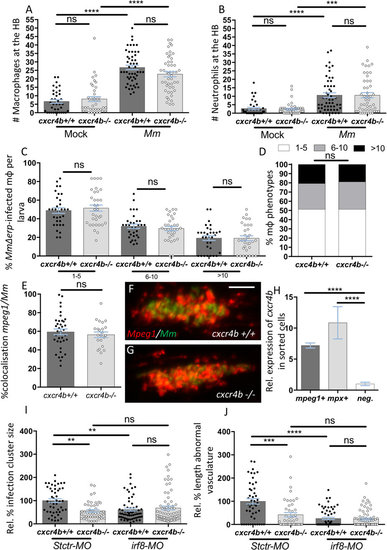Fig. 3
- ID
- ZDB-FIG-170505-23
- Publication
- Torraca et al., 2017 - The chemokine receptor CXCR4 promotes granuloma formation by sustaining a mycobacteria-induced angiogenesis programme
- Other Figures
- All Figure Page
- Back to All Figure Page
|
cxcr4b is not required for the establishment of macrophage parasitism, but macrophages are necessary to mediate cxcr4b-dependent angiogenesis. (A,B) Recruitment of macrophages (A) and neutrophils (B) 3 hours post local hindbrain (HB) infection at 2 dpf with Mm was unaffected by cxcr4b mutation. Each data point in (A,B) represents the recruitment measured in 1 embryo. Experiments were performed in 2 replicates (cumulated in the graphs), each with 17–35 embryos per group. Total number of embryos analysed: 38 (Mock-cxcr4b+/+), 41 (Mock-cxcr4b−/−), 53 (Mm-cxcr4b+/+), 49 (Mm-cxcr4b−/−). C–D cxcr4b is dispensable for the capability of macrophages to counteract intracellular replication of Mm Δerp. Infected macrophages (mpeg1:mCherry-F+) were classified into three phenotypic classes, according to the severity of intracellular infection (1–5, 6–10, or >10 bacteria). (C) represents the percentage of macrophages per larva that populates each class. (D) represents the overall distribution of macrophage phenotypes (macrophages from all larvae cumulated). Experiments were performed in 2 replicates (cumulated in the graphs), each with 16–17 larvae per group. Total number of larvae analysed in C: 32 (cxcr4b+/+), 33 (cxcr4b−/−). Total number of macrophages analysed in D: 387 (cxcr4b+/+), 334 (cxcr4b−/−). (E–G) % of mpeg1:mCherry-F signal overlapping with Mm-GFP signal in cxcr4b−/− and cxcr4b+/+. No significant deviation in macrophage composition of the trunk granuloma lesions was detected. Each data point represents 1 granuloma. Experiment was performed in 1 replicate. Total number of granuloma analysed: 37 (cxcr4b+/+), 23 (cxcr4b−/−). Representative example images are shown in (F and G). (H) Expression of cxcr4b in macrophages (mpeg1+) and neutrophils (mpx+). Both cell subsets express cxcr4b at significantly higher levels than the negative (non-fluorescent) cell population. Data represent fold changes relative to the negative cell fraction. Cells were sorted at 2 dpf, from at least 100 embryos. Experiment was performed in 3 replicates. I-J. Macrophages are indispensable to mediate granuloma vascularisation (I) and an increased number of neutrophils (by irf8 morpholino knockdown) cannot compensate for macrophage deficiency, neither in cxcr4b−/− nor in cxcr4b+/+. Deficient bacterial expansion in irf8 knockdown condition (irf8-MO) compared to standard control morpholino treatment (Stctr-MO) can be attributed to the lack of vascularisation as suggested by non-significant differences in burden between the knockdowns and control cxcr4b−/− (J). Data are analysed as in Fig. 2A,B, but infections were performed at 33 hpf, instead of 2 dpf. Experiments were performed in 1 replicate. Total number of granuloma analysed: 47 (Stctr-MO-cxcr4b+/+), 47 (Stctr-MO-cxcr4b−/−), 61 (irf8-MO-cxcr4b+/+), 73 (irf8-MO-cxcr4b−/−). |
| Genes: | |
|---|---|
| Fish: | |
| Condition: | |
| Anatomical Terms: | |
| Stage: | Long-pec |
| Fish: | |
|---|---|
| Condition: | |
| Knockdown Reagent: | |
| Observed In: | |
| Stage Range: | Long-pec to Days 7-13 |

